Mountaineering Boots and Crampons Buyer's Guide
- Details
With practice, your boots and crampons can take you to the top of the world. Although we can’t help you with the practice, we can get you started picking out the right boots and crampons for your next mountaineering adventure. Your boots are arguably the most important part of your gear. They are like the tread on a tire -- without good boots you won’t make it to the summit. We also have you covered if your summit of choice includes traversing snowfields or climbing ice. We’ll take a look at what crampons may be suited to your boots as well as climbing aspirations.
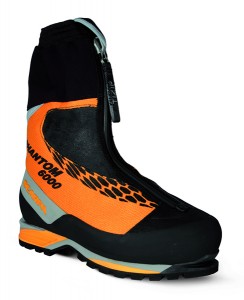 Scarpa Phantom 6000 -- double mountaineering boot
Scarpa Phantom 6000 -- double mountaineering boot
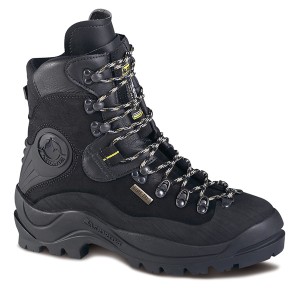 La Sportiva Lhotse -- heavyweight mountaineering boot
La Sportiva Lhotse -- heavyweight mountaineering boot
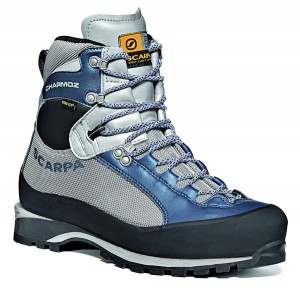 Scarpa Charmoz -- medium weight mountaineering boot
Scarpa Charmoz -- medium weight mountaineering boot
 Asolo Lothar -- lightweight mountaineering boot
Asolo Lothar -- lightweight mountaineering boot
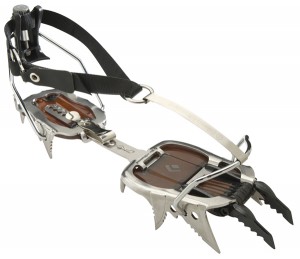 Black Diamond Cyborg crampon with automatic bindings
Black Diamond Cyborg crampon with automatic bindings
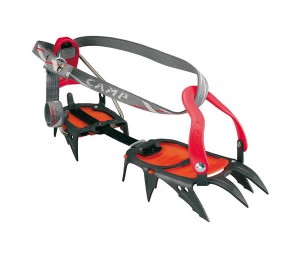 C.A.M.P. C12 crampon with hybrid bindings
C.A.M.P. C12 crampon with hybrid bindings
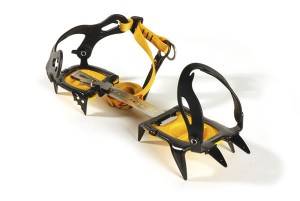 Grivel G10 crampons with strap-on bindings
Grivel G10 crampons with strap-on bindings
 Scarpa Phantom 6000 -- double mountaineering boot
Scarpa Phantom 6000 -- double mountaineering bootDouble Boots
Double are similar to ski boots in design in that they have a mold-able liner with a stiff plastic or waterproof or stiff waterproof shell. These boots are most commonly used for technical mountaineering in extreme environments, like K2 or Everest but may be employed by weekend warriors who struggle with cold feet during multi-day trips. Consult an expert if you feel you need these boots and aren’t sure what to get.Mountaineering Boots
These boots are designed for mountaineering in slightly less demanding conditions than double boots. They can range from the equivalent of heavyweight hiking boots to heavier boots designed for vertical ice and more serious mountaineering. Whereas heavier, stiffer boots perform better on snow and ice, they are less useful on the trail, and (perhaps not surprisingly) boots that perform better on the trail are less suited to the rigors of steep snow and ice. So, your intended use will determine the type of boot you need. Once you have decided on the type boot that fits your adventure needs, you should head to your local outfitter with the socks you plan on wearing. Try on several different pairs to ensure you find the fit that is best for you. While some manufactures still use leather which offers a faster break-in (but more maintenance to keep waterproof and conditioned), many are moving to high performance synthetic materials for most boots. La Sportiva Lhotse -- heavyweight mountaineering boot
La Sportiva Lhotse -- heavyweight mountaineering bootHeavyweight Mountaineering Boots
Heavyweight mountaineering boots are designed for spending lots of time on vertical ice (WI4 and above), steep snow and ice, and in truly cold conditions. A full shank will make these boots extremely stiff but allow you to use automatic or step-in crampons with ease. The shank and the high cuff will make climbing vertical ice much easier. Generally these boots are extremely waterproof and well insulated, which of course adds up to a very stiff, heavy boot. Although this is ideal in a boot if you plan on serious mountaineering, the weight and difficult break-in period keep make it a less-than-practical boot for peak baggers and weekend backpackers. Scarpa Charmoz -- medium weight mountaineering boot
Scarpa Charmoz -- medium weight mountaineering bootMid-weight Mountaineering Boots
Mid-weight mountaineering boots are designed for hiking in cold temperatures and backpacking. Some models may have a half shank to allow use of automatic or step-in crampons. These boots can be used for less than vertical ice climbing (up to WI3). Mid-weight mountaineering boots are also ideal for moderately cold weather mountaineering while still offering the adequate flexibility and reduced weight to be comfortable on the trail. This is probably the ideal boot for budding mountaineers. Asolo Lothar -- lightweight mountaineering boot
Asolo Lothar -- lightweight mountaineering bootLightweight Mountaineering Boots
Lightweight mountaineering boots are ideal for winter hiking, backpacking with large loads, cold peak bagging and approaches. Although they can be used with snowshoes and are generally stiff enough to accept strap-on crampons for limited snow and ice travel they excel on the trail, they often provide less stability over snow, ice, and very rough terrain and therefore should be reserved primarily for trail use when you don’t expect much, if any, snow or ice. Many boot models in this category are made of leather and use other (primarily synthetic) fabrics for the side panels. The result is a reduction in weight and price but typically at the expense of stability, water resistance and durability. Although some manufactures offer Gore-Tex-treated models, many will require using a third-party waterproofing treatment, such as Nikwax.Break-in and Boot Maintenance
The break-in can be a bit of a love, hate process. Lightweight boots have a relatively quick break-in period, whereas mid-weight boots may require on the order of 100 miles of wear for an adequate break-in. Heavy mountaineering boots may require as much as 200 miles of wear for that comfort fit, during which time it’s as much you breaking in the boots as the boots breaking you in (see sidebar for blister treatments). Experimenting with different sock combinations can ease some of the pain, but for the most part it is just a process you need to endure. That said, make sure you tough it out before heading into the backcountry. Boots that have not been broken in have no place on the mountain, trail or ice. It’s worth spending a lot of time getting to know your boots. Even prior to making your purchase, do more than just take a quick ‘up and back’ in the store. Ask the clerk if you can spend some more time walking around the store in the boots you’re considering, do the rest of your shopping in them (I mean, it’s not like we ever go to an outdoor equipment store for just one thing, right?). If you have any discomfort after an hour it spells disaster for multi-day trips. Or, at the very least, it suggests that a different brand of boot is going to be better long term. If you need to help speed up the break-in time, look into custom foot beds, but don’t skip the pre-purchase comfort test. With proper care, most well-made mountaineering boots will last a lifetime. After every trip inspect, clean and dry your boots. First, clean off large debris and dirt with a stiff brush. Next use a gentle soap such as saddle soap or Nikwax Cleaning Gel according to manufacturer’s instructions. Allow to dry away from any heat source as heat can damage the leather and liners. If additional waterproofing is required follow the manufacturer’s instructions. Black Diamond Cyborg crampon with automatic bindings
Black Diamond Cyborg crampon with automatic bindingsCompatibility With Crampons
Boots may have a welted heel, welted toe, or both. A boot with a heel welt can accept hybrid crampons while a boot featuring both welted heel and toe will accept automatic (or step-in) crampons. Boots lacking welts will require strap-on crampon bindings.Crampon Bindings
There are three main types of crampon bindings. The type of crampon binding you decide on will be decided by your boot type. (see left) Step-in Crampons -- require a stiff boot with welts on the toe and heel. On the heel a lever keeps the crampon tight to the boot while a front bail fits into the toe welt. These are generally used on mid and heavyweight boots with a half or full shank. Hybrid crampons -- require a heel welt but do not need one on the toe. Instead a toe strap holds them in place on the toe. Strap-on crampons -- can be affixed to almost any boot. They are simply help to the boot using nylon webbing. C.A.M.P. C12 crampon with hybrid bindings
C.A.M.P. C12 crampon with hybrid bindingsCrampons
Crampons are boot attachments that feature metal spikes to provide traction on snow and ice. They come in different configurations, are made of different materials, and have different methods of attaching to boots. It’s a good idea to take you boots with you when purchasing crampons. While most stores will be able to get you a crampon you can take home and affix to your boots there is peace of mind that comes with leaving the store knowing you are ready to start your adventure. Again, the type and binding of crampon you settle on will be decided by their intended use.Crampon Types
Rigid crampons -- are designed for climbing vertical ice (WI4 and above). The crampons are constructed to provide no flex and therefore may take some time to get used to and are not suitable for trail use, but they provide the most stable platform when front-pointing vertical ice. Semi-rigid -- crampons provide some flex --- essential for walking on icy trails or glaciers -- yet they will also provide a stiff platform for climbing less-than-vertical steep ice (up to WI3). This balance of walking and climbing performance makes this style of crampon the best choice for general mountaineering (and also the most common type of crampon available). Flexible crampons -- are generally attached to the boot with straps and are the most comfortable crampon for walking on icy trails because they allow the user to maintain a relatively normal stride. They do not, however, provide any stability for climbing and thus are best suited for occasional use on low grade terrain. Grivel G10 crampons with strap-on bindings
Grivel G10 crampons with strap-on bindings
